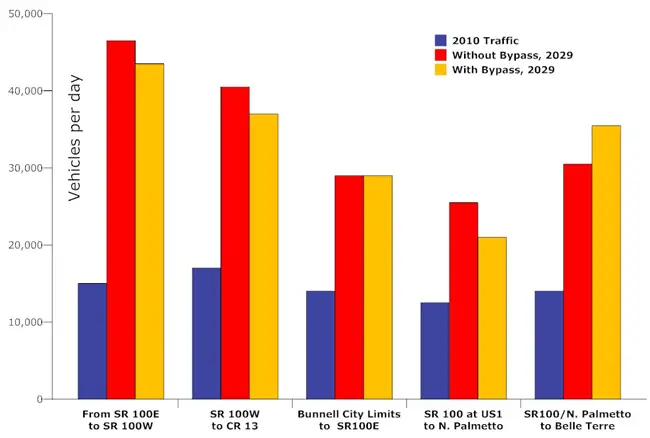
Local government and business representatives responded bitterly when first told last week of a state Department of Transportation proposal to build a bypass around Bunnell. Such a traffic diversion from the city’s business center would be like “a stake right through Bunnell’s heart,” Palm Coast City Manager Jim Landon said. Michael Chiumento III, the attorney, said a bypass would kill Bunnell all over again, as I-95 once did. Doug Baxter, the Flagler County Chamber of Commerce president, was equally unenthusiastic, predicting strong reactions from business owners.
Little of that materialized since the bypass plan was publicized and Bunnell set a public hearing on the issue for May 20. Mick Cuthbertson, Bunnell’s point man on the bypass proposal, said he’d had about 10 calls or conversations on the proposal by Friday, a response more muted than he’d expected. Opposition to the proposed study on a bypass fell when it was put in the context of better informing Bunnell’s development prospects–at no cost to Bunnell.
And an examination of studies by the Department of Transportation and the transportation consultant for the massive, 7,000-home Neoga Lakes development planned west of U.S. 1 just north of Bunnell show that the last thing Bunnell has to worry about is a drop in traffic in coming years. It wouldn’t matter if a bypass is built. It wouldn’t even matter if the mega-development wasn’t built. Traffic in the heart of Bunnell will increase regardless, and significantly so. Congestion is expected regardless, but it is “anticipated to be significantly less with the bypass in place,” a May 12 transportation department analysis concludes. If that’s the case, the argument against building a bypass to preserve Bunnell’s viability is demolished.
Calculations by both Neoga Lakes’ traffic consultant and the state transportation department show that traffic in downtown Bunnell might dip somewhat in the city center if a bypass was built, but only slightly. And with or without a bypass, traffic in downtown Bunnell is projected to double over the next 20 years. It will increase even if Neoga Lakes isn’t built, Cuthbertson says, because Palm Coast still hasn’t developed some 18,000 lots inside its original city limits. That translates to close to 50,000 more people, a portion of whose driving habits will add to Bunnell’s traffic.
Documents and correspondence exchanged between the state and the Neoga Lakes developers’ traffic consultants also show that the debate isn’t over Bunnell’s future viability, but over which portions of road improvements or construction the developer will be responsible for, and where those arteries are (or should be). Cousins Properties, the developer, is arguing that it can four-lane Royal Palms Parkway in Palm Coast for $8 million and accommodate the expected traffic surge from Neoga Lakes. The state rejects the calculations by the developer’s consultant, Daytona Beach-based Lassiter Transportation Group, saying four-laning Royal Palms won’t significantly change traffic patterns out of Neoga Lakes.
The Palm Coast government has a vested interest in this. If the Neoga Lakes has to build a bypass around Bunnell, which the state transportation department estimates will cost $20 million, that’s $20 million the developer won’t be able to spend on road improvements in Palm Coast proper. So the battle over the bypass is not so much a battle for Bunnell’s soul, but a battle over the developers’ dollars. Palm Coast wants its share. Bunnell, which has its own reasons to eye a bypass, may want its share, too.
Bunnell may well be interested in the bypass the state is proposing because the city is planning a bypass of its own, from State Road 100 south to U.S. Route 1, as part of an industrial development it’s planning for that area. The state-planned by-pass could hook into the city’s portion, possibly defraying the costs of the Bunnell part of the loop while siphoning road-development funds Palm Coast would have liked for itself.
That’s one of the reasons the Bunnell city staff, even before entertaining community responses at a public hearing scheduled for May 20 on the bypass, plans to recommend on may 24 that the Bunnell City Commission approve conducting a study on the bypass. The study doesn’t obligate the city to approve building the bypass. Nor would the cost of either the study or the bypass itself, if it’s built, be Bunnell’s responsibility. The developer of the massive development, called Neoga Lakes, would be responsible for those costs.
A May 13 email to the city administration from Nick Jebbia, a Bunnell developer, sums up the city’s position: “The more detailed data we get, the better to make an ‘informed’ decision. At this point, it would seem to make sense to have FDOT do the study as it will only generate more information that can be used in the city’s long range planning process. And at no cost to the city.”
The Department of Transportation also stresses that if Bunnell doesn’t want the bypass, it won’t be built.




























Never Fails says
Bunnell and Flagler Beach are two of a kind. “DON’T TRY TO CHANGE ANYTHING!!!!” is their motto and inevitably it comes back to bite them. In this case, Bunnell screamed about the proposal to 4 lane SR 100 within the City and that project was cancelled. Now they will pay the price, just as Flagler Beach did after they declined to provide water and sewage to new developments west of the intracostal and had to pay to upgrade the system by themselves. Of course they didn’t learn. Declined the request of the folks in Beverly Beach to help out with their water and sewage problems.
Oh well, the Potato Festival is coming!!!
Jim Guines says
It looks like some are reading the wrong study or can’t read. Why the different impact interpretations?
erp says
Bunnell By-Pass?
People living in Bunnell should be on their knees thanking their Gods that they’ll be by-passed.